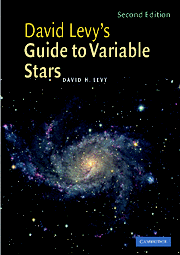Book contents
- Frontmatter
- Contents
- Foreword to the first edition
- Preface
- Acknowledgments
- Part I Getting to know the sky
- Part II Getting to know the variables
- 5 Meeting the family
- 6 Getting started with Cepheids
- 7 Algol, the demon of autumn
- 8 How to estimate a variable
- 9 Names and records
- 10 How your observations help us understand a variable star
- 11 Observing hints
- 12 Observing with CCDs
- 13 Stately and wonderful
- 14 Stars of challenge
- 15 Bright, easy, and interesting
- 16 Betelgeuse: easy and hard
- 17 Not too regular
- 18 Nova? What nova?
- 19 Supernovae
- 20 Clyde Tombaugh's star and the family of cataclysmic variables
- 21 A nova in reverse?
- 22 RU Lupi?
- 23 Orion, the star factory
- 24 Other variable things
- 25 The Sun
- Part III Suggested variables for observation throughout the year
- Part IV A miscellany
- Index
19 - Supernovae
from Part II - Getting to know the variables
Published online by Cambridge University Press: 05 August 2012
- Frontmatter
- Contents
- Foreword to the first edition
- Preface
- Acknowledgments
- Part I Getting to know the sky
- Part II Getting to know the variables
- 5 Meeting the family
- 6 Getting started with Cepheids
- 7 Algol, the demon of autumn
- 8 How to estimate a variable
- 9 Names and records
- 10 How your observations help us understand a variable star
- 11 Observing hints
- 12 Observing with CCDs
- 13 Stately and wonderful
- 14 Stars of challenge
- 15 Bright, easy, and interesting
- 16 Betelgeuse: easy and hard
- 17 Not too regular
- 18 Nova? What nova?
- 19 Supernovae
- 20 Clyde Tombaugh's star and the family of cataclysmic variables
- 21 A nova in reverse?
- 22 RU Lupi?
- 23 Orion, the star factory
- 24 Other variable things
- 25 The Sun
- Part III Suggested variables for observation throughout the year
- Part IV A miscellany
- Index
Summary
A thousand years ago
There is something magical about a star that, in its final phase of life, announces its end to the entire Universe. On July 4, 1054, Chinese skywatchers were stunned by something new in the sky. The “guest star” they reported was the outburst of a supernova, triggered by a major instability and collapse within the star. Since then at least three other supernovae have been easily visible from Earth, in 1572 and 1604, a time when European civilization was just about ready to accept new thoughts on the stability and arrangement of stars in space, and in 1987, when our understanding of the process of a supernova was finally good enough to be tested.
The Chinese were not the only ones who might have recorded the guest star of 1054. In 1054, native American records consisting of a rock carving in what is now Chaco Canyon, New Mexico, welcomed a bright new star in Taurus with a waning crescent Moon right next to it. More accurate Chinese records have given us information so that we can pinpoint the date of the event as July 4, 1054. Much brighter than nearby Aldebaran, the exploding star would have been visible in daylight.
For a few days around January 4, 2003, the sky put on a repeat performance, as the planet Saturn happened to be precisely at the spot of the supernova of 1054.
- Type
- Chapter
- Information
- David Levy's Guide to Variable Stars , pp. 104 - 111Publisher: Cambridge University PressPrint publication year: 2005



